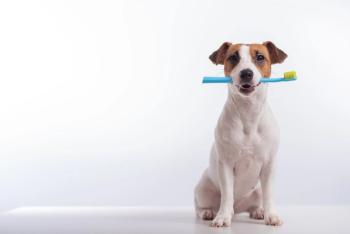
CVC highlight: How to handle chronic vaginitis in veterinary patients
Dr. Davidson and Tomas Baker, MS, discuss a common genitourinary condition that all veterinarians should be ready to manage in their female canine patients.
Despite the fact that most client-owned pets in the United States are neutered, you will come across disorders of the genitourinary tract in your practice. Chronic vaginitis, which is often seen in female dogs that have undergone an ovariectomy, is one that you should be ready to handle.
Autumn Davidson, DVM, MS, DACVIM
Clinical signs
Affected dogs will have variable vulvar discharge, which is often mucoid to hemorrhagic or purulent, usually accompanied by licking, scooting, and pollakiuria. Perivulvar and vulvar dermatitis are also frequently present.
Tomas Baker, MS
Five common causes
Chronic vaginitis develops for multiple reasons, and the primary cause is often masked and exacerbated by previous therapies such as long-term antimicrobial therapy, self mutilation, and topical irrigations.
Vaginal mucosal biopsy frequently shows nonspecific lymphocytic-plasmacytic inflammation, but sometimes suppurative (neutrophilic) or eosinophilic inflammation is predominant. Primary bacterial vaginitis is rare.
GETTY IMAGES/LIFEONWHITE
Vaginal cultures can show overgrowth of an atypical bacterial species (pure gram-negative cultures, resistant organisms, Pseudomonas species) or pure culture of Mycoplasma species if antibiotics have been used extensively. Occasionally, a yeast overgrowth is identified.
In your affected patients, consider these five causes:
1. Extensive perivulvar dermatitis associated with redundant dorsal and lateral vulvar folds
2. A granulomatous uterine stump (note: be sure to rule out stump pyometra)
3. Vaginal foreign bodies such as foxtails or bone fragments
4. Chronic urinary tract infection with urethritis, vestibulitis, or vulvitis
5. Cystic, urethral, vaginal, or vestibular neoplasia
We also often see vaginal strictures, but they are not usually causal. Most cases are idiopathic.
Diagnostic strategy
Perform a complete blood count, serum chemistry profile, urinalysis (preferably on a sample acquired by cystocentesis), and urine culture. Also perform a careful vaginal examination while the patient is heavily sedated or anesthetized with endoscopic equipment that will allow you to evaluate the entire vaginal vault.
This usually means a rigid cystourethroscope with saline infusion is a necessity. Otoscopes and vaginal speculums do not permit adequate evaluation of the entire vaginal vault. And pediatric proctoscopes lack the sensitive optics of cystourethroscopes.
Radiography (vaginography, urethrography, cystography, intravenous pyelography) or ultrasonography of the entire genitourinary tract can help you localize the problem and eliminate differential diagnoses. Ultrasonography is preferable since it does not require anesthesia.
Vaginal cytology, aerobic and mycoplasma vaginal cultures from guarded culturette swabs, and pinch biopsies of affected vaginal mucosa may help better define the problem. Any contributory anatomic abnormalities found are important, including significant strictures, mass lesions, redundant dorsal vulvar folds, and anomalous ureteral anatomy.
It is helpful to evaluate the patient in a normal standing position to accurately assess external anatomy (are there redundant folds?), followed by examinations after urination and after recumbency (are urine pooling and scalding noted?). Urine pooling in the vaginal vault noted only when the patient is anesthetized can be misleading, and the presence of redundant vulvar folds are difficult to ascertain when the patient is positioned for vaginoscopy.
Treatment plan
General treatment guidelines apply to most cases:
- Discontinue topical irrigations.
- Prevent self mutilation with Elizabethan collars.
- Initiate antimicrobial therapy only when indicated by proper interpretation of culture and sensitivity testing. Limit antimicrobial therapy to cases in which pathogens have been identified as displacing normal flora.
Analgesia and anti-inflammatory therapies are indicated in many cases. A short anti-inflammatory course of corticosteroids can help diminish vaginal inflammation, but the subsequent propensity for urinary tract infection must be kept in mind, and problems with long-term use limit usefulness. Thus, nonsteroidal anti-inflammatories are preferred. Narcotics such as tramadol may be necessary for adequate analgesia.
If a specific cause is identified, resolution is more straightforward. Surgical correction with careful postoperative control of self mutilation is indicated if anatomic abnormalities have contributed to or caused the condition. And the identification and removal of foreign bodies should cure chronic vaginitis. Appropriate management of chronic urinary tract infection if identified should resolve associated vaginitis. Therapy of urogenital neoplasia can include surgery and chemotherapy.
If the condition is idiopathic, oral estrogen replacement therapy is often helpful in establishing normal mucosal integrity and eventual normalization of the vaginal vault. The condition is likely similar to postmenopausal vaginitis in women secondary to low estrogen concentrations. Women improve with vaginal estrogen application, which is difficult in dogs. Compounded oral diethylstilbestrol (DES) is advised; the dose is empiric and usually the same as that used for urinary incontinence due to sphincter incompetence. Several weeks of therapy with estrogen may be required before improvement is recognized. Side effects are uncommon; mild overdosage results in signs of proestrus (attraction to male dogs, vulvar swelling). Myelosuppression is highly unlikely if the dosage is conservative (a 60-lb dog would receive 1 mg once or twice a week).
Autumn Davidson, DVM, MS, DACVIM, and Tomas Baker, MS, Small Animal Internal Medicine Service, School of Veterinary Medicine, University of California, Davis, California.
Listen in
Dr. Davidson tells you all about puppy vaginitis—and why it's not anything to be too concerned about—in this snippet from her CVC presentation. Just scan the QR code above or go to
Newsletter
From exam room tips to practice management insights, get trusted veterinary news delivered straight to your inbox—subscribe to dvm360.




